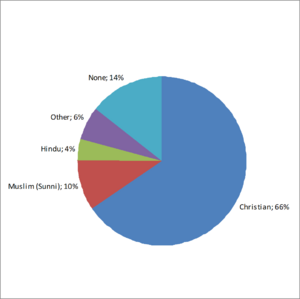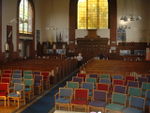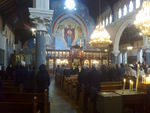Culture of Austenasia
Austenasian culture is the pattern of human activity and symbolism associated with the Empire of Austenasia and its people. It is a primarily Western culture heavily influenced by that of the medieval Roman "Byzantine" Empire at a national level and often by the culture of the surrounding larger nation in regards to the individual exclaves of the Empire. It has been shaped since the foundation of the Empire by the customs, ideas, and contributions of those who have joined or been associated with Austenasia.
Language
English is the most commonly spoken language in Austenasia, known and used daily by the majority of the population. English is generally the only language used for government business, although some Latin is rarely used for more ceremonial occasions. There are exceptions to the dominance of English in Austenasia. In Enfriqua, French is the vernacular; Marathi in Imperia; Turkish in Chalcedon and Trebizond; Ukrainian in Chersoneses; and Estonian in Oppidum Tubae; Mandarin Chinese in Shuhan; and Dutch in Helinium. In New Pontunia, Pontunian, a constructed language, is an official language.
Latin is also - rarely - used in some ceremonial contexts, such as the national motto and the consular names of each year's Consuls. Swedish held the status of an official language in New South Scotland from the start of its administration by Zealandia in June 2014 until being repealed in April 2020, but had not been commonly used there since the return of the crown dependency to imperial governance in September 2016.
Music
The national anthem of Austenasia is God Save the Emperor.
Two Austenasian nationals - Centurion A. Hayes and Lord John Gordon - are independent artists, publishing music under the names of Metaphonic EDM and FezIndieArtist respectively.
Media and broadcasting

Residents of the Austenasian enclaves around the world read newspapers imported from and watch television channels broadcasted from their neighbouring countries. The Austenasian Times is the semi-official Austenasian news service, founded by Jonathan I in November 2012 while he was still Crown Prince. Porthbokon News, existed as a local news service in the Empire, catering primary to the Town of Porthbokon before its dissolution in 2017.
Austenasia has its own broadcasting corporation, Austenasian Television Productions (ATP). ATP, founded in December 2008, produces films for Austenasian Events, a set of small documentaries which record events concerning the Empire. It also publishes Cool Barbie, a sci-fi fantasy drama about a Barbie's encounters with extraterrestrials and villains in a world where toys are alive. Public broadcasts by the Monarch and Prime Minister are also published online by ATP. All of these films are published on the ATP YouTube account, where they can be viewed free of charge.
Religion

Since 21 June 2017, Austenasia has been an officially Christian country. Christian feast days are celebrated as public holidays, and Christian symbols are used for example in the national coat of arms, but freedom of Austenasians to choose and practice their own religion has been guaranteed by law since December 2008, and is entrenched under Article XII, Paragraph C of the Constitution.
Out of all Austenasian subjects and residents to respond, 85.6% profess belief in a religion, with 14.3% either identifying as atheist or agnostic.
The majority of Austenasians to respond to Home Office surveying on this topic - eighty two people (65.6%) - identify themselves as Christians of some kind; thirty nine Protestants, twelve Orthodox, twenty five Roman Catholics, and six from other non-mainstream groups. Of the remaining religious population of Austenasia, Sunni Islam and Hinduism have twelve and five adherents respectively. Eight individuals are listed as "Other": two Humanists, two Taoists, two Pagans, one "Jedi", and one who identifies simply as "Spiritual".
From the founding of Austenasia in September 2008 until the introduction of the first non-residential subject in April 2010, the entirety of Austenasia's population identified as Methodist Christians. As the number of new subjects grew, so did Methodism decline within Austenasia, and today is professed by under 5% of the population.
Christianity
From the founding of Austenasia until March 2011, all four residents of Wrythe attended Carshalton Methodist Church, with rates of attendance varying for each resident ranging from every Sunday to special occasions such as Christmas services. The church was the site of the Merger Club between 2005 and 2009, and was (and is still) regularly attended by the former residents of Zephyria. Two instances in 2009 - a Sunday in June, and Christmas Day - witnessed the whole population of Austenasia attending the morning services, possibly the only times in history that an entire nation has been present at a single religious service. Several crosses made of palm leaves given out at Palm Sunday services can be seen on the mantelpiece in Parliament Hall in the Imperial Residence.
Austenasia's only officially recognised place of worship is a miniature roadside Orthodox Christian chapel located in Kaiomenia. The small shrine is dedicated to Saint Menas, and is situated on the edge of the road which marks the border between Kaiomenia and the neighbouring country of Greece, in which such small roadside chapels are common.
Roughly two thirds (65.6%) of Austenasians to respond to surveying are Christians, mostly Western:
Christian denominations in Austenasia:
- 25 Roman Catholics
- 12 Orthodox
- 11 Baptists
- 6 Methodists
- 4 Anglicans
- 4 Lutherans
- 1 Pentecostal
- 1 Salvationist
- 13 Other Protestants
- 3 Jehovah's Witnesses
- 2 Christian Druids
- 2 Mormon (Latter-day Saint)
These figures do not include the fifteen Austenasians who have not responded regarding religion to the Census, at least some of whom may presumably be Christian, which would make the true numbers higher than what is recorded.
HIM Emperor Jonathan I converted from Methodism to the Orthodox Church in early 2011 and was chrismated on 24 July later that year.
-
The interior of Carshalton Methodist Church, c. 2007
-
The interior of the Greek Orthodox Church of Saints Constantine and Helen, 2013
-
The interior of St Anne's Roman Catholic Church, attended by residents of Bregusland, 2020
Religion and the law
Religious topics have often been referenced in Austenasian statutes.
- October 2008 - Act 10 (Public Holidays): Easter Sunday and Christmas Day were made official public holidays, with Jesus Christ being referred to as "Our Lord" and as "our Lord and Saviour".
- 13 December 2008 - Act 30 (Human Rights): "the right to choose and practice" a "religion, faith or belief without persecution" was officially affirmed.
- 21 March 2009 - Act 68 (Revised Human Rights): the rights granted in Act 30 were reaffirmed in a revised and expanded version of the Act, which also forbade discrimination on the basis of faith and affirmed the right of someone to profess a "religion freely, to change it and to practise it either on their own or with others".
- 23 August 2009 - Act 91 (Religious Toleration): consolidated the previous affirmations on human rights in regards to religion into a single Act, and declared that places of worship of any religion would be permitted to be built in the Empire.
- 23 August 2009 - Act 92 (Right of Sanctuary): created the right of sanctuary for those hiding from pursuers in a church, and made it a crime to violate a sanctuary.
- 20 September 2011 - Article XII of the Austenasian Constitution of 2011: Section C reaffirms the provisions of Act 91, and Section Q guarantees the right to marry to anybody, regardless of their religion.
On 22 September 2011, all Acts of Parliament passed under the Austenasian Constitution of 2008 were repealed, as the Austenasian Constitution of 2011 was fully implemented. However, the human rights granted in regards to religion under the 2008 Constitution were preserved in Article XII of the 2011 Constitution, and are now entrenched due to not being able to be repealed without a referendum.
On 21 June 2017, Christianity was declared the state religion of Austenasia by the passage of the State Religion Act 2017. No denomination in particular was specified, but rather Trinitarian Christianity as a whole.
Politics
Although Austenasia is a parliamentary monarchy, the Constitution enables the Austenasian Monarch to wield and exercise substantial executive, legislative, and judicial power. The Austenasian government was originally based loosely on that of the United Kingdom, with the Monarch playing a mostly ceremonial role and most power and influence being wielded by the Prime Minister. The reign of Emperor Esmond III saw the Monarch beginning to be viewed as a symbol of the nation itself, and the powers and influence of the Monarch increasing at the expense of the elected legislature. This process continued after his reign, with the Austenasian Constitution of 2011 transferring many of the executive powers of the legislature - most notably the power to appoint Cabinet ministers - to the Monarch. Under the current reign of the incumbent Emperor Jonathan I, the Monarch is the indisputable chief executive of the Empire.
Since the reign of Esmond III, a world-view often known as the Imperium theory has grown in popularity within Austenasia, being partially adopted by official legislation during the reigns of Jonathan I and his predecessor. This worldview, which is both officially and popularly adhered to by the other Carshalton Nations and also particularly prevalent amongst the Austenasian Armed Forces, attaches significant importance to the title "Emperor", viewing the Austenasian Throne as being in succession to that of the Roman Emperors. This has helped accelerate the increase of monarchical authority in Austenasia and also resulted in several Roman elements being adopted by the Empire, such as a Latin national motto loosely based on SPQR, a system of annually-appointed consuls, and addition of Roman imperial titles to the official style of the Monarch.
Monuments
The capital city of Wrythe has been home to three structures known as monuments. The oldest, Wrythe Pet Cemetery, was constructed in late 2008 by order of Emperor Terry I, by unearthing the coffins of two previously buried deceased pet goldfish and translating the graves to a new site, alongside a third recent burial. Four more burials have taken place at Wrythe Pet Cemetery since July 2009, and repairs are carried out annually.

Another monument, also ordered by Emperor Terry I (but constructed under Emperor Esmond III and unveiled in January 2011, by which time Emperor Declan I also held the Throne) is Wrythe Genocide Memorial. This is a simple stone stele which was unveiled on International Holocaust Remembrance Day 2011 to commemorate the memories of all genocide victims.
The most recent monument constructed in Wrythe was the Orange Pyramid, built under the orders of Crown Prince Jonathan in honour of Emperor Declan I and Wilcslandian culture, and unveiled on 12 April 2011. The base of the pyramid was comprised of blocks of cement, whereas the main outside walls were constructed out of pieces of orange pottery (hence the name "Orange"), and the pyramid was filled inside with pieces of masonry, cement, pottery and gravel. After practically collapsing in under a year due to lack of structural integrity, the pyramid was completely rebuilt in May 2012 in celebration of the Tin Jubilee of Declan I as Wilcslandian monarch, with some parts of the old monument being re-used in the construction of the new. The pyramid was destroyed in February 2014 by strong winds knocking branches of a nearby bush into it, and the ruins were cleared away by Wrythe Town Council in late June 2015.
National symbols
Public holidays
The Empire celebrates several national public holidays each year, many of which are Christian feast days. Public holidays are officially defined in the Public Holidays Act 2014 as "days of celebration, on which employers are encouraged to offer leave from work to their employees." Many other holidays may be adopted for observation by individual Towns and Territories. Furthermore, three (two if Remembrance Sunday and Armistice Day coincide) other days are nationally observed each year as days of commemoration, but not as holidays, and any public or bank holiday in the United Kingdom is also observed as a public holiday in Austenasia. The feast day of the patron saint of a specific Town or Territory, and/or of a nation of which a significant proportion of the residents of the respective Town are also members, may also be celebrated locally.
In regards to the several holidays which are dated in relation to Easter, local authorities decide whether to observe the holiday in relation to Western Easter, Orthodox Easter, or both.
| Date | Name | Type | Notes |
|---|---|---|---|
| 1 January | New Year's Day | Public holiday (national) | The start of the new year, traditionally observed by the Imperial Family with a walk on Wimbledon Common. |
| 6 January | Epiphany/Theophany | Public holiday (national) | Celebrating the revelation of Jesus Christ to the world. |
| 20 January | Imperial Ascension Day | Public holiday (national) | The anniversary of the ascension to the Throne of Emperor Jonathan I. The date of the holiday will change upon the ascension of the next Monarch. |
| 2 February | The Presentation of the Lord/Candlemas | Public holiday (national) | Commemorating the presentation of Jesus Christ at the Temple in Jerusalem. |
| 27 February | Empress Day | Public holiday (national) | The birthday of the Empress consort. |
| 25 March | The Annunciation | Public holiday (national) | Celebrating the proclamation of the Incarnation by the Archangel Gabriel to the Virgin Mary. |
| The Sunday before Western and/or Orthodox Easter. | Palm Sunday | Public holiday (national) | Commemorating the entry into Jerusalem of Jesus Christ. |
| The Friday before Western and/or Orthodox Easter. | Good Friday | Public holiday (national) | Commemorating the crucifixion of Jesus Christ. |
| The first Sunday after the first full moon on or after 21 March according to the Gregorian calendar. | Western Easter | Public holiday (national) | Celebration of the resurrection of Jesus Christ. Should this date coincide with that of Orthodox Easter, they are observed concurrently, simply as "Easter". |
| The first Sunday after the first full moon on or after 21 March according to the Julian calendar. | Orthodox Easter | Public holiday (national) | Celebration of the resurrection of Jesus Christ. Should this date coincide with that of Western Easter, they are observed concurrently, simply as "Easter". |
| The Monday after Western and/or Orthodox Easter. | Easter Monday/Bright Monday | Public holiday (national) | |
| The Thursday 40 days after Western and/or Orthodox Easter. | Feast of the Ascension | Public holiday (national) | Celebrating the Ascension of Jesus Christ into Heaven. |
| The seventh Sunday after Western and/or Orthodox Easter. | Pentecost | Public holiday (national) | Celebrating the descent of the Holy Spirit. |
| The day after Pentecost. | Whit Monday/Monday of the Holy Spirit | Public holiday (national) | Celebrating the descent of the Holy Spirit. |
| 22 April | Earth Day | Public holiday (national) | To "be observed with events and activities that promote environmental awareness, conservation, and sustainable practices". |
| 4 June | Imperium Day | Public holiday (national) | The anniversary of the recognition of the imperial rank of the Throne by the then German Emperor in 2011. |
| 6 August | Feast of the Transfiguration | Public holiday (national) | Commemorating the Transfiguration of Jesus Christ upon Mount Tabor. |
| 14 September | Feast of the Cross | Public holiday (national) | Celebrating the discovery of the True Cross by Saint Helena. |
| The third Saturday in September. | Independence Day | Public holiday (national) | Celebration of the Empire of Austenasia's Declaration of Independence on 20 September 2008. |
| 26 September | St. John's Day | Public holiday (national) | Feast of Saint John the Apostle, patron saint of Austenasia. |
| 13 October | Emperor Day | Public holiday (national) | The birthday of Emperor Jonathan I. The date of the holiday will change upon the ascension of the next Monarch. |
| 5 November | Imperial Wedding Anniversary | Public holiday (national) | Celebration of the anniversary of the wedding of Emperor Jonathan I and Empress Hannah. |
| 25 December | Christmas | Public holiday (national) | Celebration of the birth of Jesus Christ. |
| 17 May | Pets Day | Day of commemoration | Officially only to commemorate deceased pets, but also used as an occasion to express appreciation and affection to living pets. Flowers are laid on each grave in Wrythe Pet Cemetery. |
| 11 November | Armistice Day | Day of commemoration | Observed separately to Remembrance Sunday should it not fall on the same day. Commemorating all those who have fought and died in war, specifically the First World War and those since. Traditionally observed with one or two minutes of silence at 11 am. |
| The second Sunday in November. | Remembrance Sunday | Day of commemoration | Commemorating all those who have fought and died in war. Traditionally observed with one or two minutes of silence at 11 am. |
| 25 January | Burns Night | Public holiday (optional, may be adopted by local authorities) | Celebrating the life and works of the poet Robert Burns. Traditionally celebrated with an evening meal of haggis. |
| The Tuesday 47 days before Western Easter. | Shrove Tuesday/Pancake Day | Public holiday (optional, may be adopted by local authorities) | Traditionally observed with the eating of pancakes so as to use up rich foods before Lent. |
| The Wednesday 46 days before Western Easter. | Ash Wednesday | Public holiday (optional, may be adopted by local authorities) | Observing the first day of Lent in Western Christianity. |
| The seventh Monday before Orthodox Easter. | Clean Monday | Public holiday (optional, may be adopted by local authorities) | Observing the first day of Orthodox Great Lent. |
| The Tuesday after Western and/or Orthodox Easter. | Easter Tuesday/Bright Tuesday | Public holiday (optional, may be adopted by local authorities) | |
| The Tuesday after Pentecost. | Whit Tuesday/Third Day of the Trinity | Public holiday (optional, may be adopted by local authorities) | |
| 8 May | Alternative/extra date for the celebration of Saint John's Day. | Public holiday (optional, may be adopted by local authorities) | Saint John's Day may by decision of the local Town Council or Governor be celebrated on this date instead of (or as well as) the national date of 26 September. 8 May is observed in Orthodox Christianity as a secondary feast day of St John in commemoration of a miracle reported to have taken place at his tomb. |
| 24 June | Carshalton Day | Public holiday (optional, may be adopted by local authorities) | Celebrating the anniversary of the Liberation of Orly, as well as the shared culture and history of the Carshalton Nations. |
| 15 August | Assumption of the Virgin Mary/Dormition of the Theotokos | Public holiday (optional, may be adopted by local authorities) | Commemorating the death and ascension into Heaven of the Virgin Mary. |
| 1 September | Ecclesiastical New Year | Public holiday (optional, may be adopted by local authorities) | Celebrated by the Orthodox Church and some Methodist churches as the start of the new church year. |
| 8 September | Birth of the Virgin Mary/Nativity of the Theotokos | Public holiday (optional, may be adopted by local authorities) | Feast of the birth of the Virgin Mary. |
| 29 September | Michaelmas | Public holiday (optional, may be adopted by local authorities) | Feast of the Archangel Michael in Western Christianity, patron saint of the Austenasian Throne. |
| 5 November | Bonfire Night | Public holiday (optional, may be adopted by local authorities) | Celebration of the thwarting of the Gunpowder Plot of 1605, traditionally observed with fireworks and the lighting of bonfires. |
| 8 November | Synaxis of the Archangel Michael and the other Bodiless Powers | Public holiday (optional, may be adopted by local authorities) | A celebration of the Orthodox Church in honour of the Archangel Michael, patron saint of the Austenasian Throne, and of all other angels anyone may wish to commemorate. |
| 21 November | Presentation of the Virgin Mary/Entry of the Theotokos | Public holiday (optional, may be adopted by local authorities) | Commemorating the entry of the Virgin Mary into the Temple in Jerusalem. |
| 24 December | Christmas Eve | Public holiday (optional, may be adopted by local authorities) | A day of both religious and secular preparation for Christmas Day. |
| 27 December | Alternative/extra date for the celebration of Saint John's Day. | Public holiday (optional, may be adopted by local authorities) | Saint John's Day may by decision of the local Town Council or Governor be celebrated on this date instead of (or as well as) the national date of 26 September. 27 December has been observed in Western Christianity since the medieval period in place of the older September date. |


